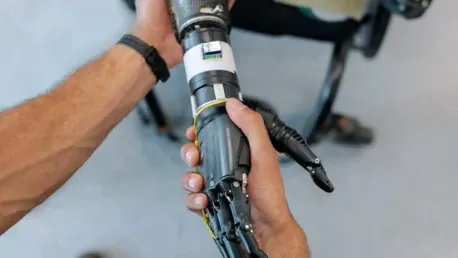Listen to the Article
Since the dawn of time, people have adapted to their environment, whether that be developing tools to hunt or discovering fire to cook. In this way, humans have become reliant on tools and technology to facilitate their lives and develop skills that make task execution more efficient and speedier.
Today, the world faces unprecedented global crises that have forced a blurred boundary between man and machine. From wearable devices to biological fusions, human augmentation technology is quickly gaining popularity for enabling people to overcome everyday constraints and enhance sense.
The question is: What if the next step in human evolution isn’t catalyzed by nature, but by technology? Let’s take a look.
The Technological Frontier of Human Augmentation
Relying on Brain-Computer Interface Power
At the intersection of technology and neuroscience lies human augmentation—with the power to enhance cognition, sensation, and action. For example, brain-computer interfaces (BCIs) are a popular technology that enables people to communicate with external devices through brain activity instead of peripheral nerves and muscles, to translate intentions into commands. This extraordinary evolution in neurotechnology shows various fascinating applications—empowering physically challenged individuals to accomplish goals that were once far from reality.
By bypassing the brain’s ordinary output channels, BCI devices use real-time detection of specific neural pathways to perform a task. Neuralink, Elon Musk’s neurotechnology company, is pioneering an implantable BCI that will restore movement or vision to individuals with paraplegia or who are born blind—known as the Link. This coin-sized chip is surgically implanted under the skull, where it transforms motor skill neural threads into actions via electrical currents.
In addition to this endeavor, Neuralink is creating an app that will enable impaired individuals to use a computer keyboard and mouse with their minds by interpreting complex data sets through machine learning algorithms. These technologies also hold the potential to enhance human memory and cognitive functions through the direct interface between people’s brains and digital devices.
Lending a Hand to Bionic Limbs
In a similar light, researchers and product developers are pioneering a new age of bionic limbs, where neural signals power robotic prosthetics. Bionic limbs empower individuals who have lost a body part, such as an arm or leg, to regain independence by making artificial additions feel more biological. From enhancements in primary robotic components to machine learning, key technological advancements have paved the way for bionic limbs to propel prosthetic innovations.
State-of-the-art prostheses are now so advanced that amputees can restore a natural walking gait through robotic sensors and predefined algorithms—entirely driven by a person’s nervous system. MIT researchers have discovered a way to reconnect residual limb muscles to deliver proprioceptive feedback to amputees when linked with their prosthetics through surgical intervention and neuroprosthetic interface. This procedure enables affected individuals to increase motor speed and avoid obstacles more seamlessly than traditional methods.
Developing Robotic Exoskeletons
Technology has advanced so much that people can now wear a mechanical device known as a robotic exoskeleton to execute physically demanding tasks. Power-enhancing exoskeletons increase strength and endurance, such as lifting heavy weights or walking for more extended periods of time.
The Lockheed Martin Onyx exoskeleton uses artificial intelligence data from users’ feet, knees, and hips to make movement easier. First responders and military personnel use this technology to tackle tasks like charging up hills weighed down by cargo and storming staircases loaded with firefighting gear.
Ford has also jumped on the bandwagon and employs exoskeletons to reduce the fatigue of assembly line workers. In collaboration with Ekso Bionics, Ford’s wearable technology, called EksoVest, supports workers’ arms during overhead tasks through adjustable lift assistance of 5-15 pounds per arm. Designed with the construction and distribution industry in mind, these vests offer greater levels of protection and support against overexertion by reducing bodily stress and strain.
The Vulnerabilities of Human Augmentation
As is the nature of emerging tech, human augmentation comes with its own set of inherent risks, such as cybersecurity and privacy. There is a pressing concern for the security of augmented systems akin to that of mobile devices, with an amplified possibility of biological breaches. However, differently from a simple smartphone, technology like BCI involves data that could be life-threatening in the wrong hands. Human augmentation certainly proves to be a double-edged sword, with heightened abilities sitting on the fence between efficiency and error.
The accelerated adoption of augmentation technology also splits global power dynamics in half. Countries without access to these innovations are at a disadvantage, highlighting inaccessibility issues and introducing a new form of inequality. Additionally, such devices could divide the employment landscape and lead to job displacement. For example, exoskeletons deliver a level of automation for physical labor that can decrease the demand for manual workers.
On a greater level, human augmentation technology can infringe on individual privacy rights as devices used to hold meetings, shop, observe heart rates, and other everyday activities are monitored regularly. These devices rely on this data to customize and personalize experiences with an algorithm; however, this includes confidential information. By doing so, this technology records users’ locations, movements, and communication patterns and covertly shares them with servers. This increases the chances of information leaks and restrikes the risk of security breaches.
Conclusion
Evolution is inevitable, but what will cause it? Today’s world dictates technology as the next driver for adaptation, with the promise of human augmentation. By enhancing cognition, strength, and sensations, the future is full of possibilities for people to work and live with a new sense of innovation, efficiency, and progress. With limitless potential, human augmentation tech even offers physically challenged individuals the chance to regain independence and confidence in their everyday lives.
However, with such a wealth of advantages, the scale must be balanced. Before the widespread adoption of human augmentation technology can be achieved, people must question the moral quandaries associated with technology governing biological systems. Between individual issues like neurological control and societal consequences like inequality, it’s essential that before man merges with machines, people must balance technological progress with humanity.









